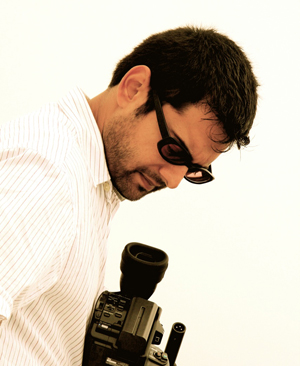We make films to have a dialogue with our audience & communities. Our viewers, and how we connect with them, is such a bit part of the equation, that we spend a TREMENDOUS amount of time discussing the business: how do we discover films? how do we aggregate audiences? how do we achieve a sustainable career? And so on and so on and so on.
The answer always remains the question of “How do we make better films?”. I am a big believer that all filmmakers need to know what they love (and how to strive to achieve it). I am also a believer that audiences benefit from the same knowledge. I know we don’t discuss this enough. It’s personal. It is difficult to articulate. But we must make the effort. It’s worth it. We can build it better together. Thankfully Kevin Shah has stepped forward; someone always needs to get on the dance floor first!
Making a Contemporary American Art Film
Although what constitutes the ‘success’ of any artistic endeavor is entirely subjective, there are some fundamentals that I believe great art films can share. Ted and I briefly lamented that there are few videos on the internet about ‘making an art film’, or aesthetics of cinema and it’s process, or personal attempts to explore Transcendence on screen from a director’s perspective. This is my attempt at scratching the surface through our own experiment called White Knuckles – a feature film by sabi.
Art films often have characters with complex or even unclear motivations, and especially in scenes that don’t depict the characters moving toward a specific goal. Often these scenes are artistic, moody and beautiful — but despite this, we’ve learned often these scenes end up edited out of the final film. An art film’s effect doesn’t stem from specific moments — it stems from how the viewer feels about the journey the character’s take throughout the entire experience (and its resolution). If the scene must say something unique and honest between the lines on the page to foster deep empathy within our audience, then we must get to the heart of what the scene is about (what our character’s central driving motivation is) and communicate it to the cast and crew precisely in order to execute. Only then, can the collaborative team organically shape what springs forth: by being in-the-moment and present to what is happening around them on set, and remaining open to explore surprises or subtlety as it happens.
Directing this experiment was about bringing a well-defined shell of a character to an actor to make their own, and then re-defining the entire story for that specific actor. And together, taking the emerging character on a more authentic journey than scripted to discover greater questions about life, love, and forgiveness. Directing the improvisation throughout this story was more of a spiritual practice than a craft with steadfast rules. Dramatic improv is about collaborating with your actor to find the character’s voice in a safe, family-like atmosphere. It’s not about collecting ‘off-script’ options for the editor.
In order to survive, genuine collaboration is a need in all artistic feature film endeavors today. I truly prefer not to see my vision exactly as it appears in my head (I already have that vision of the story and it’s fine the way it is). When embarking on a new film, I want to work with our team to make something more powerful than anyone could achieve alone. Something that can only be called an “Interdependent Film” because of the family that worked together to make both the process and the result of the experience unique and meaningful.
As White Knuckles enters the world and finds its audience (recently picked up by Vanguard Cinema) we hope it will continue to spark discussion and debate about this parable of forgiveness that ends in a moment of transcendence, captured as honestly as it happened. This ‘making-of’ video contains creative lessons we definitely intend to bring to more ‘genre’ endeavors, and shares our experience to inspire you to take your own artistic journey.
Learn more about The Sabi Company’s artistic & commercial endeavors at www.thesabicompany.com
 Kevin K. Shah is a creative artist-entrepreneur / ‘interdependent storyteller’ with several feature films, shorts & documentaries he’s written, directed, produced or been an integral part of. He’s also worked with several studios on high-profile transmedia campaigns including special concepts, webisodes, behind the scenes, mobile content & interactive games. With the feature ‘White Knuckles’, Kevin wanted to experiment with an immersive collaborative experience in order achieve honesty and authenticity in character and emotion. He is presently CEO of The Sabi Company and is currently packaging ‘A Falling Rock’ a thriller & and is in post on ‘Lucid’ a horror-drama he directed. Kevin begins production on ‘Down and Dangerous’ with director Zak Forsman this fall. Found on Twitter @kevinkshah, or www.kevinshah.com or www.thesabicomapny.com
Kevin K. Shah is a creative artist-entrepreneur / ‘interdependent storyteller’ with several feature films, shorts & documentaries he’s written, directed, produced or been an integral part of. He’s also worked with several studios on high-profile transmedia campaigns including special concepts, webisodes, behind the scenes, mobile content & interactive games. With the feature ‘White Knuckles’, Kevin wanted to experiment with an immersive collaborative experience in order achieve honesty and authenticity in character and emotion. He is presently CEO of The Sabi Company and is currently packaging ‘A Falling Rock’ a thriller & and is in post on ‘Lucid’ a horror-drama he directed. Kevin begins production on ‘Down and Dangerous’ with director Zak Forsman this fall. Found on Twitter @kevinkshah, or www.kevinshah.com or www.thesabicomapny.com
 It is a rich topic, and we need to think about it far more than we — the filmmaking community — do. Here’s a start:
It is a rich topic, and we need to think about it far more than we — the filmmaking community — do. Here’s a start:

 Kevin K. Shah is a creative artist-entrepreneur / ‘interdependent storyteller’ with several feature films, shorts & documentaries he’s written, directed, produced or been an integral part of. He’s also worked with several studios on high-profile transmedia campaigns including special concepts, webisodes, behind the scenes, mobile content & interactive games. With the feature ‘White Knuckles’, Kevin wanted to experiment with an immersive collaborative experience in order achieve honesty and authenticity in character and emotion. He is presently CEO of The Sabi Company and is currently packaging ‘A Falling Rock’ a thriller & and is in post on ‘Lucid’ a horror-drama he directed. Kevin begins production on ‘Down and Dangerous’ with director Zak Forsman this fall. Found on Twitter
Kevin K. Shah is a creative artist-entrepreneur / ‘interdependent storyteller’ with several feature films, shorts & documentaries he’s written, directed, produced or been an integral part of. He’s also worked with several studios on high-profile transmedia campaigns including special concepts, webisodes, behind the scenes, mobile content & interactive games. With the feature ‘White Knuckles’, Kevin wanted to experiment with an immersive collaborative experience in order achieve honesty and authenticity in character and emotion. He is presently CEO of The Sabi Company and is currently packaging ‘A Falling Rock’ a thriller & and is in post on ‘Lucid’ a horror-drama he directed. Kevin begins production on ‘Down and Dangerous’ with director Zak Forsman this fall. Found on Twitter 